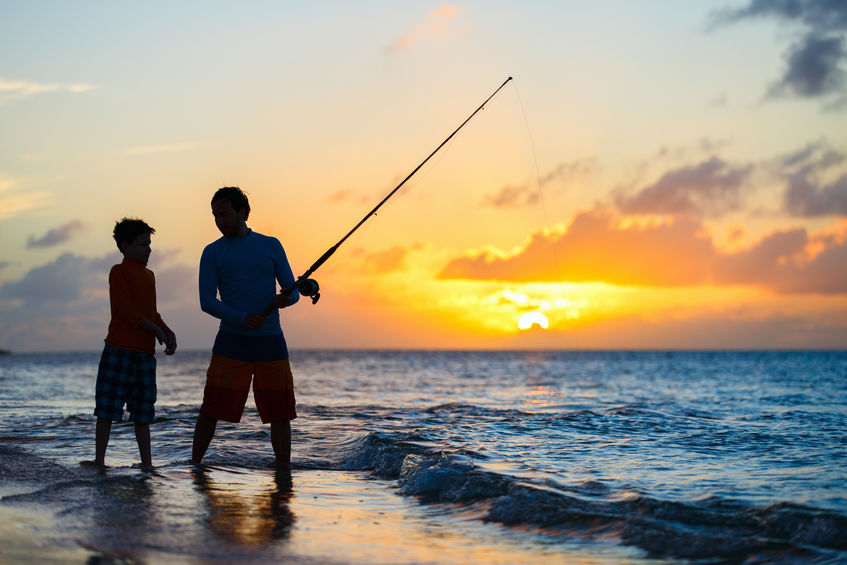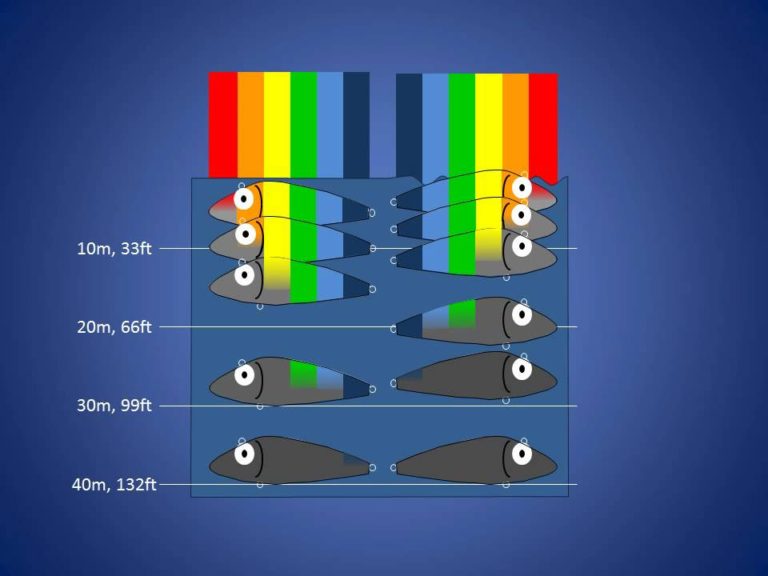A new question for Anglers these days is what color fishing line is the best to use in day or night time fishing. Choosing a color for salt or freshwater or whether a fish will be able to see any colors at different depths or not has become a science. Just how important it is to success is a matter of opinion. Does fishing line color matter?
Yes-salt & freshwater absorb different wavelengths of light at certain depths. Longer waves like red are first to be absorbed, then orange & yellow. Fishing lines use those colors along with Clear, Green, or Blue to blend in the backdrop where fish live, giving fish less chance of seeing the line.
At various depths and conditions in the ocean or lakes, fish can see colors depending on what that color is and what the surrounding conditions are. This can help with lure and line choice and allows anglers to make the best decisions for fishing. Fish can see the contrast, color shadings, reflected light, shape, and movement, which accounts for the acceptance or rejection of artificial lures more than colors will.
Best Color Fishing Line for Saltwater
In underwater testing, all colors of fishing lines were compared side to side in relatively clear water at Florida’s Keys and you can actually see that the least visible line in the seawater was white-colored. Next, it was blue but again this was water at the Keys where the water clarity was excellent even at depths of 20 to 30 feet.
The color of the water was an aqua green color and the water surface was bright whitish that giving the white line its invisible characteristics. Not representative of most ocean water that I’ve seen before. After that, it was dark green and Red. All water environments are unique in color and all have discrepancies.
Then the next comparison environment was a pond. The pond was shallow and had darker weeds in it but the light still penetrated the shallow water. With a dark brown backdrop with green and browns in the bottom weeds, this was a fairly good comparison for a Bass hole and the natural colors you would see.
What color that was the least visible was dark green The brackish type of water wasn’t muddy but the earth colors made some lines stand out and some lines disappear. From the top, the easiest color to see was yellow and red.
This experiment shows under different characteristics and conditions found in certain locations whether oceans, ponds, or rivers whatever is the backdrop or colors inside that environment determined what color line will be seen and what colors won’t. There will be a green aqua hue or tint to some clear water or brownish brackish type colored water that will be on shallow banks of southern lakes.
The fluorocarbon fishing line is still clear, because of its filament type, it actually invisible underwater than a standard clear monofilament fishing line. Since the carbon fishing line is nearly invisible, it’s a great choice for pretty much any water and will be especially helpful in very clear water, as the nearly invisible line will be that much harder for easily frightened fish to see.
Manufacturers of Pink Fluorocarbon say that this color while pink seems to be an odd color the makers say that it’s totally invisible and at higher depths, for fish and anglers to see. Bright neon yellow or green is used for anglers to spot and control their lines and not so much for fish. The fisherman needs to see the line on or under the surface that can give him an edge. With yellow and other bright colors that are made for the fisherman rather than the fish.
Especially fish that are aggressive and hungry in rainy weather or darker days. It makes sense that if fish can’t see the line or color then it should be better for the possibility of the fish taking a bite of whatever is at the end of it. The high-vis yellow color is great for anglers who watch their lines to detect bites.
This color is an angler’s choice for fishing in dirty water, but in clear water, the line is fairly easy to see underwater. It’s a trade-off for anglers looking to see their line, and adding to the equation is that aggressive fish may not notice the line as they are about to strike a lure.
The yellow line does have a time and place and the benefit of being able to detect bites may outweigh any possible reduction in bites from line-wary fish. Personally, I don’t get it because most fish in the ocean normally take and dive deep with little finesse.
Most water ocean or fresh has a green hue to it so it makes for a logical camouflage but if the fish can see it 100 feet down because water won’t absorb its wavelength will it be counterproductive to use for fishing lines. The one problem is that water won’t absorb green light for up to 100 feet which can make it a valuable color to attract fish in a fish-light situation but will it be good in a line color at deep depths of the ocean?
“Traditionally, bronze and green are great line colors for inshore saltwater fishing,” says Mark Schindel, director of sport-fishing and outdoor products at Cortland Line. Muddy substrate, sea-grass flats, oyster bottom, and off-colored water help the line disappear, offering a stealthy approach to stalk fish. In Jersey, we use that color in clam beds of the flats in tint color water. ”They also added red because it’s the first to go neutral in the water column. He says that red doesn’t quite disappear but rather it just becomes darker as depth increases.”
Water absorbs different wavelengths of light to different degrees. The longest wavelengths, with the lowest energy, are absorbed first. Red is the first to be absorbed, followed by orange & yellow. The colors disappear underwater in that order as they appear in the color spectrum. Even water at a 5ft depth will have a noticeable loss of red.
If we use a color that is harder to see under certain depths and the big Control features which would include the environment backdrop, that would be the color and backdrop of the water, then the odds should be better for the fish not seeing the fishing line.
How Long Does Fishing Line Last?
Monofilament line has an average life of 2-3 yrs
Fluorocarbon lines can last 5-7 yrs
Braided line can last up to 10 yrs +
Spooled mono & fluoro lines become brittle over time & weaken when exposed to saltwater, heat, & UV rays ……………………………………. Read more
Best Color Fishing Line for Freshwater
Colors that Disappear the deeper you go:
- Red-15 foot Orange- 25 foot
- Yellow 35-45 foot
- Green-70-75 Foot
Naturally fishing in the ocean will be different than lake or river fishing. Then, there is what specific type of fish you are looking to catch. If Bluefish schools are on top or bottom in 100 feet of ocean water they won’t care what color your fluorocarbon fishing line is they will hit on beer cans. But a Smallmouth Bass in 30 ft of freshwater who travels the parameter of the lake’s edge preying on small minnows just might.
Of all colors, underwater clear, blue, and red are the best. Studies show that lures or objects that are colored red are lost in minimal amounts of water. If you ask 5 different anglers about what color fishing line to use then you’ll get 5 different answers.
When to Use Colored Braided, Fishing Line
Green Braid Is Low Vis –One of the most popular colors for a braided fishing line is green and that is for a reason. Green braid often blends in super well in nutrient-rich waters such as bays, lakes, inlets, etc. where the fish might get bigger and more power is needed.
Where You Should Use Green Braid
- Inshore Fishing
- Bay Fishing
- Inlet Fishing
Where Should you use Yellow Braided Line
- Offshore Fishing
- Inshore Fishing When
- Throwing Baits Next To Trees Or Structures Make Sure You Use Fluorocarbons
Braided fishing lines are times referred to as super lines. They can carry huge loads at a fraction of the diameter of the traditional monofilament line. This can allow anglers to fit more lines on their reel as well as to reach greater depths when they are bottom fishing. The braided line has a little stretch that can give the angler an edge to catch smaller bites coming from great depths.
What is a Biodegradable Fishing line?
Biodegradable fishing line is an alternative to the standard nylon-based line made from a completely biodegradable polymer engineered to look and work the same but degrades 100X faster than traditional monofilament & fluorocarbon fishing line creating much less of a threat to wildlife & environment .……………………………………………… Read more
Multi-Colored Monofilament Fishing Line
If you are fishing for Bass in 35 ft. or more of water you need a lure color that the fish will see- you need a Fishing line color that the fish won’t see. Like fishing lines colored red or green. A red lure or fly will lose its color after 10 ft. or so and start to look grey and as it gets deeper it will look black. The wavelength filtering will also work sideways in a horizontal direction.
The less depth the more clarity the more color because of less absorption. Simply put, for colors to be seen it has to be hit by light. Other conditions also apply like muddy water or darker skies at night or from a storm. The line can be fluorocarbon, monofilament, or some type of braided material in multiple colors. Some color fishing line suggestion is:
 Yellow-as mentioned earlier is for anglers who want to watch their lines to detect bites. The bright color can easily be seen up top and down below by the fish. The color of this line is a good choice for muddier water or bottom water involved with silt.
Yellow-as mentioned earlier is for anglers who want to watch their lines to detect bites. The bright color can easily be seen up top and down below by the fish. The color of this line is a good choice for muddier water or bottom water involved with silt.
The Red-colored line is the first color to become invisible at the lowest depth. The Red pigment doesn’t lose color but rather changes darker until it turns black. The color Red can be seen by fish in Contrast at deep depths far down into the ocean, but it is seen as the color Black.
There is some truth that is coming to light by research scientists saying some manufacturers were selling fish hooks that were the color blood red.
They were claiming that fish were biting on the hook because they saw the color of the hook. In reality, the fish were seeing the contrast in the water which was dark black against the backdrop of color that was in the environment at that depth.
The fish sees the color as a contrast to what’s in the fish environment where the fish is living. As the water gets deeper the colors are changed in stages as in the case of Red turning to Grey and then turning to Black. Contrast is being looked at by Scientists as a reason why Fish has an exceptional way of seeing colors underwater.
Green- is a good natural type color and green or a hue, tint, or something close to Green is found in water around the world. Like camouflage, Greenline blends into its surroundings and makes a good choice for anglers looking to keep their line invisible to fish.
In clearer water, Greenline won’t be any good because its wavelength can hang around in deeper water where it may stand out. For average water types Green is a good choice when not knowing what to use for sure.
Clear & Blue-Clear monofilament is a good choice if you are concerned about fish being able to see your line in any depth of water. While the properties of fluorocarbon may make it less visible underneath the surface, clear monofilament works well in all situations. Blue can be advantageous to the anglers as they get a better visual of the Blue tinted line laying on top of the water.
What are the Characteristics of a Fishing Line?
Fishing lines generally resemble a long, ultra-thin rope, with important attributes including length, material, weight, & thickness. Other factors relevant to certain fishing environments include:
Breaking strength,
Knot strength,
UV resistance
Castability
Limpness
Stretch
Abrasion resistance
Visibility ………………………………………………………………… Read more
Jim Galloway Author/Editor



